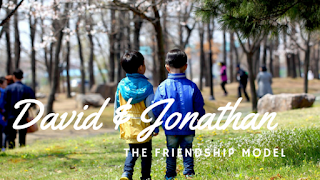Friendship is defined as a relationship of mutual affection
between two people. It is a stronger form of interpersonal connection than an
association. Our friends can have a profound influence on us often in subtle
ways and more than our family of origin. However, we need to be careful about
the companions we keep as Proverbs 13:20 says “He who walks with the wise grows
wise, but a companion of fools suffers harm.” As Walter Winchell, an American
newspaper and radio gossip commentator, once said “A real friends is one who
walks in when the rest of the world walks out.” How do you know a true friend
from a fake friend? What is a model of a true friendship?
True friends are more than just companions who enjoy each
other’s company. They encourage each other’s faith in God and trust each other
with deepest thoughts and oldest confidences. True friends also should help,
not hinder us, as we draw closer to God. As Psalm 1:1 says “Blessed is the man
who does not walk in the counsel of the wicked or stand in the way of sinners
or set in the seat of mockers.” We must ask ourselves: do our friends build up
our faith or do they tear it down? Proverbs 17:17 says “A friend loves at all
times and a brother is born for adversity.” The greatest evidence of a genuine
friendship is loyalty. Being able to help in times of distress or personal
struggles. Too many friendships are fair-weather friends. They stick around
when things are good and leave at any signs of conflict or bad times. True
friends practice sacrificial love: listening, helping, encouraging and giving.
John 15:13 says “Greater love has no one than this, that he lay down his life
for his friends.” It is putting our needs and wants aside for a friend. Jesus
is a great example of a true friend as he is more than Lord and Master but a
friend (John 15:15).
Fake friends are often hard to spot because we don’t want to
believe that a person that we care about is not a true friend. If we look
closely, to spot a fake friend. Here are a few signs to look out for. First,
fake friends are selfish. They only want contact when they want or need
something. Sledge calls this friend a “Kanye,” the relationship revolves their
needs, wants and even opinions. Second, fake friends thrive on gossip and
drama. These friends also known as “emotional vampires” as they leave you
feeling drain and empty. Mary DeMuth calls these friends “Dramatic Drakes”, as
these individuals have a need for drama and even thrive on it. Third, fake
friends lie, and they can lie about everything. They lie about their
accomplishments in school, at work, in their other relationships. It doesn’t
matter what it is, they will lie to make themselves look better than you.
Lastly, they are not trustworthy. They will not hold confidences and will
gossip about you to others. This friend is known as a “Brutus” the friend who
stabs you in the back. Oscar Wilde said, “True friends stab you in the front.”
Proverbs 27:6 even says “Wounds from a friend can be trusted, but an enemy
multiplies kisses.” A true friend’s advice, confrontation, whatever it is and
no matter how painful, is better than an fake friend’s betrayal.
A great model of a true friendship is found in the relationship
between David and Jonathan. It is one of the deepest and closest relationship
recorded in the Bible. 1 Samuel 18:1-2 says that Jonathan was “one in spirit
with David” and “loved him as himself.” David and Jonathan became close friends
as soon as they meet. Their relationship was based on their commitment to God,
not just each other. They let nothing come between them, not career or family
issues, his father, King Saul would attempt to kill David multiple times. As
the son of King Saul, Jonathan was the rightful heir for the throne of Israel,
but he recognized David was called by God to be the next king (1 Samuel 23:17)
and he did not allow this to come between them because he rather lose the
throne than lose his friend (1 Samuel 20:4). David and Jonathan relied on each
other when their friendship was tested especially when Saul was determined to
kill David (1 Samuel 19). They remained friends until the end when Jonathan was
killed in battle (1 Samuel 31:2). When David heard of his friend’s death, he mourned,
wept and fasted (2 Samuel 1:12).
In conclusion, friends are hard to find. True friends are
even harder. While we go through life and multiple true and fake friends, we
need to remember to find a true friend, we need to be a true friend. We need to
look closely at ourselves and make sure we aren’t behaving in ways which keeps
us from true friends. We need to be supportive and encouraging. We need to
listen and communicate honestly and openly. A true friend is there when it
seems that everyone else has left. They are there through thick and thin, in
good times and in conflict. Friendships are also a two-way street, what you get
from it is what you put into it. Sometimes friendships need to end especially
when it is bad for us. It’s okay to grieve the ending of a friendship. It is
okay to miss a friend but sometimes that friend is not good for us and we need
to say goodbye.
References
DeMuth, Mary. The
Seven Deadly Friendships
Sledge, Benjamin. The 5 Types of Fake Friends to Avoid. www.blog.heartsupport.com/the-5-types-of-fake-friends-to-avoid-175375e10d52.
Retrieved January 24, 2019





































